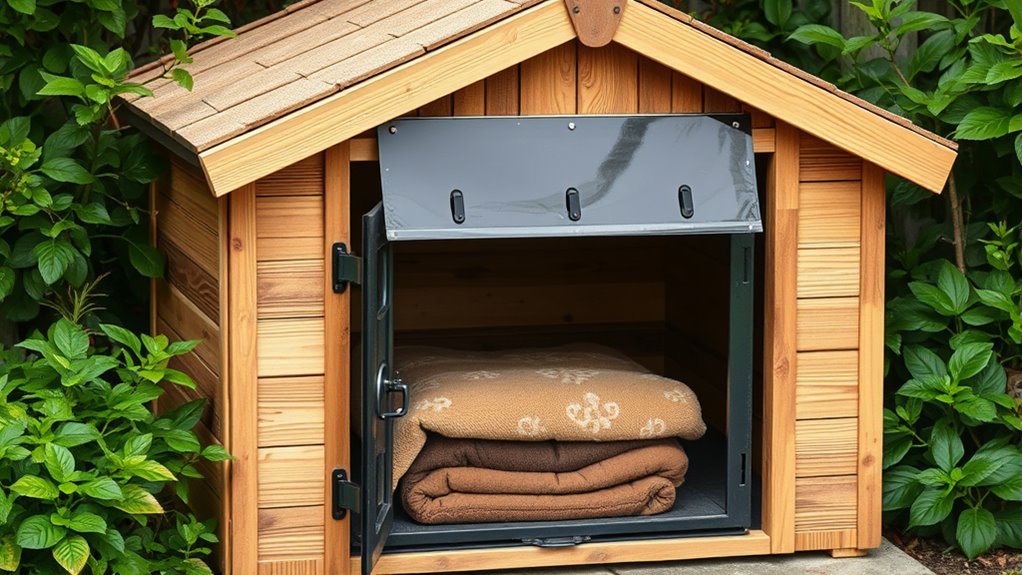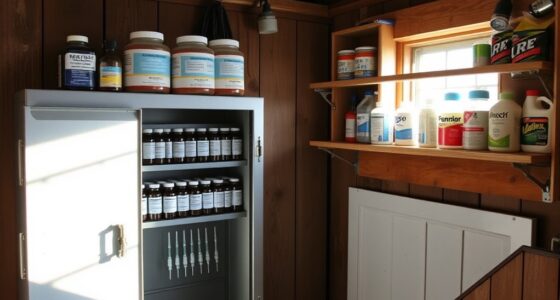To build a predator-proof outdoor cat shelter, choose durable, weather-resistant materials like treated wood or metal and secure all panels with rust-proof fasteners. Incorporate predator-resistant entries with small, angled openings, and elevate the shelter on legs or platforms to deter ground predators. Camouflage it by blending with natural surroundings using bark, leaves, and local foliage, and guarantee proper ventilation and weatherproofing. Continuing further will reveal detailed steps to keep your cats safe and secure.
Key Takeaways
- Use durable, weather-resistant materials and secure all panels with rust-proof fasteners to prevent predator entry and damage.
- Position the shelter among natural cover like bushes or trees for concealment and predator deterrence.
- Incorporate predator-proof entry points with small, angled openings and secure heavy-duty latches.
- Elevate the shelter using stakes or sturdy foundations to prevent ground predator access and flooding.
- Regularly inspect and maintain the shelter for damage, reinforce stability, and keep the environment free of hiding spots.
Selecting Durable and Secure Materials

Choosing the right materials is essential to building a predator-proof outdoor cat shelter. Your material selection directly impacts the shelter’s structural integrity, ensuring it withstands weather and potential threats. Opt for sturdy, durable materials like heavy-duty plastic, weather-resistant wood, or metal, which won’t easily break or be chewed through. Avoid flimsy options that predators can easily penetrate or damage. Securely fasten all panels with rust-proof screws or nails to enhance stability. Insisting on high-quality, robust materials will create a safe environment where your cats can rest without worry. Remember, the goal is to build a shelter that remains intact over time, providing reliable protection against predators and the elements. Proper material selection is your first step toward a secure, long-lasting shelter. Understanding material durability is vital for ensuring your shelter remains predator-proof over the years. Additionally, selecting materials with weather-resistant properties will help prolong the lifespan of the shelter and maintain its protective qualities. Using materials with insulation capabilities can also help keep your cats warm in colder weather, adding an extra layer of protection. Considering additional protective features, such as secure locks or predator-proof vents, can further enhance the shelter’s defenses against intrusion. Ensuring that you choose appropriate insulation materials can significantly improve your shelter’s ability to protect against harsh weather conditions.
Designing a Shelter With Predator Deterrents
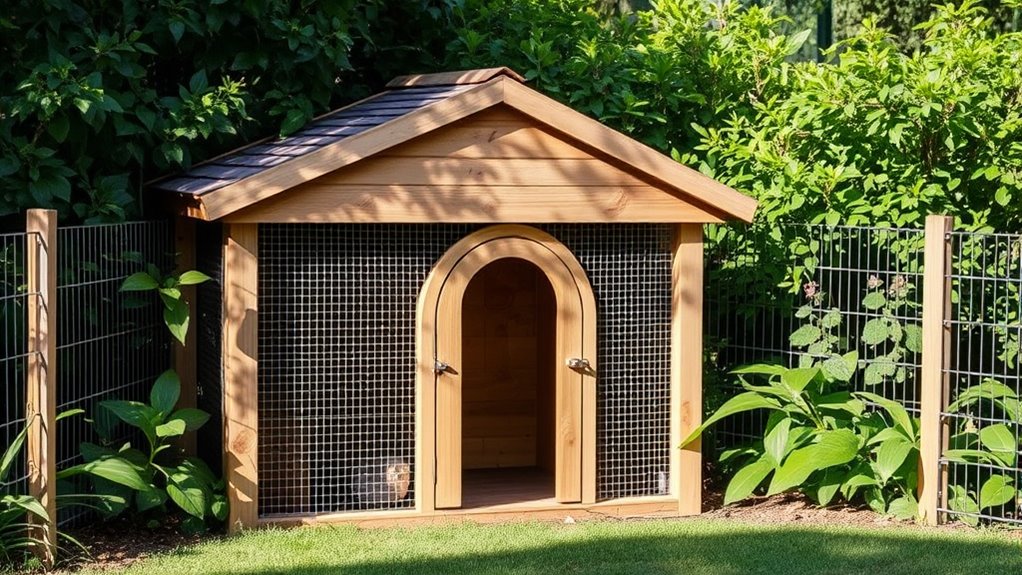
To effectively deter predators, incorporate strategic design features into your outdoor cat shelter. First, choose a location that blends with your garden aesthetics, making it less obvious to predators. Use sturdy, predator-resistant materials and secure all entry points with heavy-duty latches. Incorporate raised platforms or legs to prevent ground-level attacks. To guarantee shelter portability, select lightweight but durable materials that allow you to move the shelter easily if needed. Consider adding a predator-proof entrance with a small, angled opening that prevents larger animals from entering. Keep the shelter well-ventilated to avoid condensation, and avoid placing it near dense shrubbery or hiding spots that predators might use. Additionally, choosing a preppy dog name can help you personalize your shelter, making it feel more like a part of your home environment. Ensuring proper shelter placement can further reduce the risk of predator encounters, and selecting the right outdoor materials is crucial for durability and safety. Creating a sense of security through thoughtful design will help maintain a safe, discreet environment for your cat while maintaining your garden’s visual appeal.
Building a Elevated and Enclosed Space
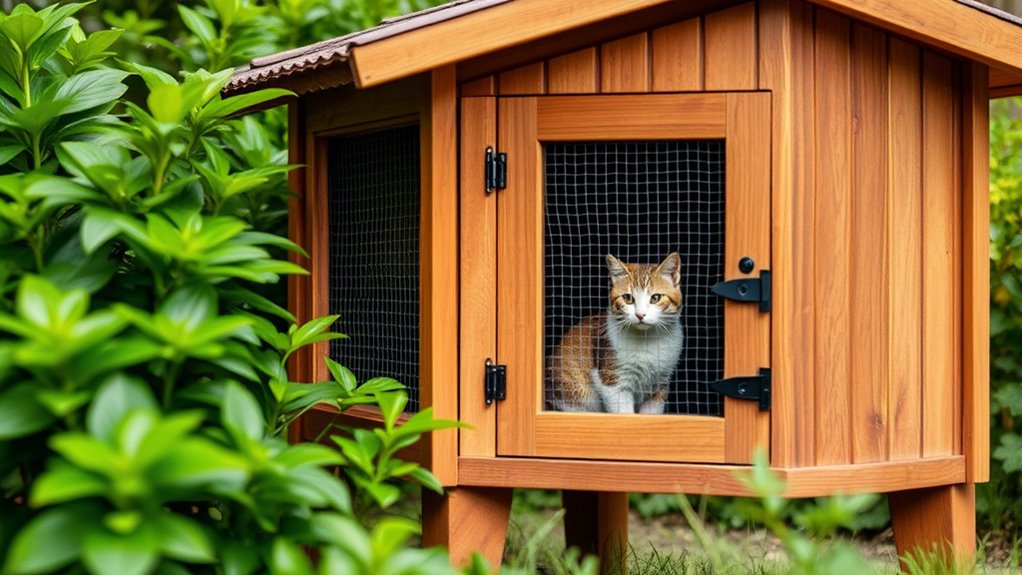
Elevating and enclosing your outdoor cat shelter creates a safer environment by adding an extra layer of protection from ground-level predators and harsh weather. When building this space, consider climate factors like insulation and ventilation to keep your cat comfortable year-round. An elevated design helps prevent flooding and keeps the shelter dry, especially in rainy seasons. Aesthetically, choose materials and colors that blend with your yard, ensuring the shelter looks natural and unobtrusive. Proper enclosure not only shields your cat from wind and rain but also discourages predators from accessing the space. Additionally, understanding local injury prevention laws and guidelines can help you design a shelter that adheres to safety standards and offers maximum protection. Incorporating shelter durability considerations ensures that the structure withstands weather conditions over time, maintaining safety and comfort for your feline friend. To optimize the shelter’s longevity, selecting organic materials can contribute to a healthier environment and reduce chemical exposure. Including filtering systems for air circulation can further improve ventilation and reduce humidity inside the shelter. Incorporating automation technologies like sensors for monitoring temperature and humidity can further enhance your cat’s comfort and safety.
Installing Secure Entry Points and Locks
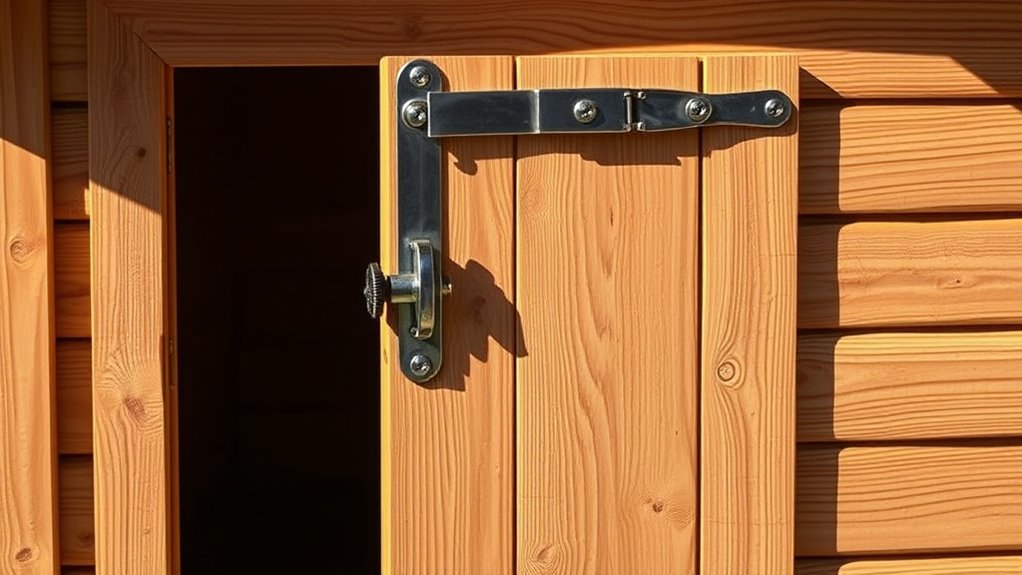
Installing secure entry points and locks is essential to prevent unwanted visitors from accessing your outdoor cat shelter. Understanding animal behavior and predator habits helps you choose the right features. To enhance security:
Secure entry points and locks keep predators out and your cats safe.
- Use heavy-duty, predator-proof latches that resist tampering.
- Install overlapping doors or double-entry systems to deter predators.
- Ensure entry points are small enough to prevent large predators from slipping inside.
- Secure all hinges and seams with reinforced hardware.
- Selecting the right grocery savings strategies can help you afford quality shelter materials without breaking the bank. Incorporating wicks designed for outdoor use can also improve the durability of your shelter’s seals and closures. Additionally, choosing materials with animal-proof features can further enhance the shelter’s defenses.
Predators often exploit weak spots, so tight seals and sturdy locks are vital. Recognizing their habits, such as attempting to claw or pry open doors, guides your choices. Properly installing these features creates a robust barrier that predators can’t breach, keeping your cats safe and secure.
Incorporating Camouflage and Natural Cover
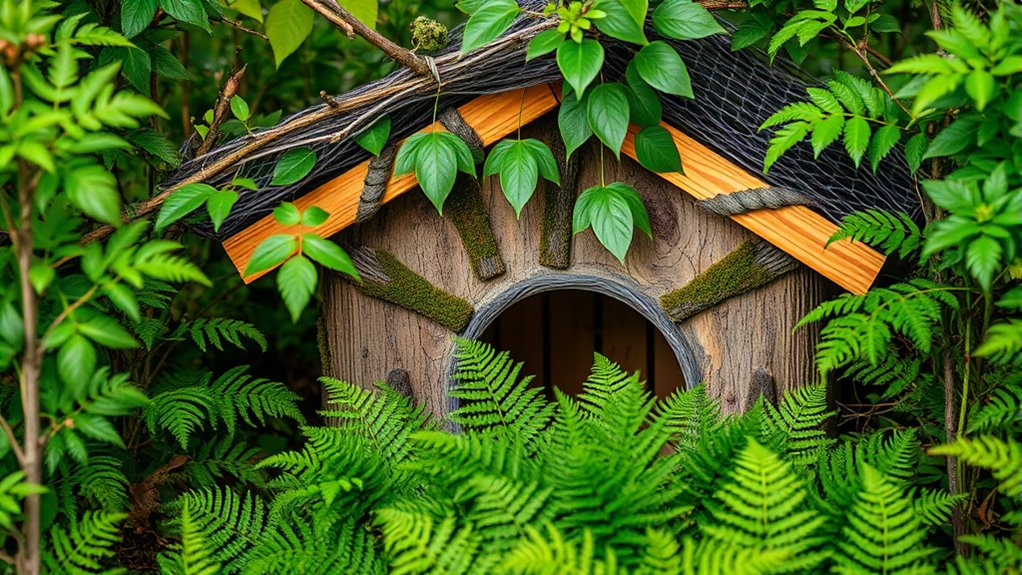
Integrating camouflage and natural cover into your outdoor cat shelter helps it blend seamlessly into the environment, making it less noticeable to predators. Use camouflage techniques like painting the shelter with earth-tone colors or attaching natural materials such as bark, leaves,, or grass to its exterior. These methods help break up the shelter’s outline and reduce its visibility. Consider natural cover options like planting bushes or tall grass around the shelter, which provide additional concealment. Strategically placing the shelter among existing foliage or under tree canopies further enhances its disguise. Utilizing wall organization systems with natural elements can create additional visual interest and functionality, while also aiding in concealment. Incorporating power management techniques can ensure the shelter remains operational and protected from weather elements. Additionally, understanding wildlife behavior can help you position and disguise the shelter more effectively. Observing local wildlife patterns can offer valuable insights to optimize concealment strategies tailored to your area. By disguising your shelter with these techniques, you create a safer space where your cat can rest and stay protected from prowling predators, all while maintaining a harmonious look within your yard. Additionally, employing networking with local wildlife experts can provide insights into effective concealment strategies tailored to your area.
Ensuring Proper Ventilation and Insulation
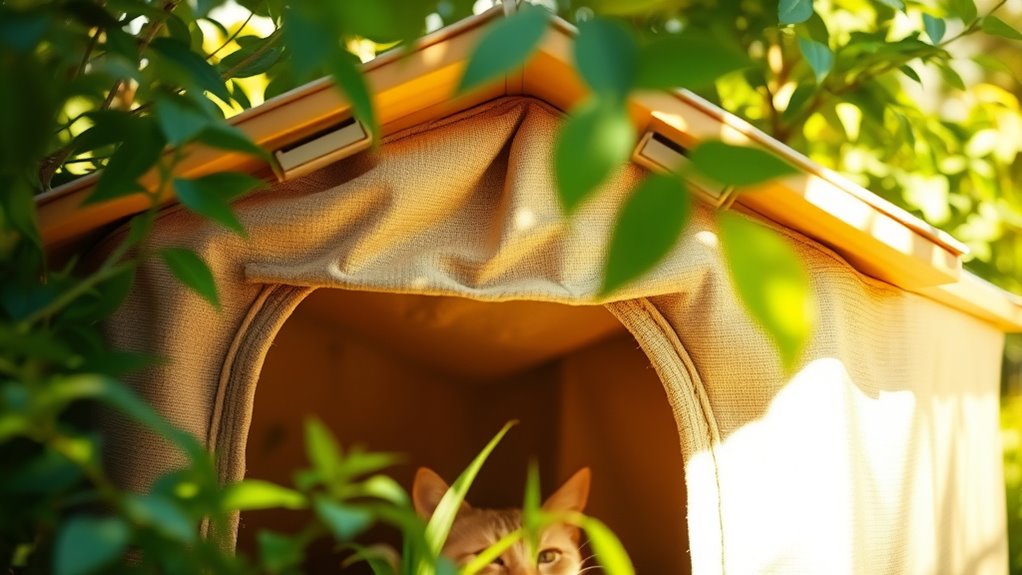
While disguising your outdoor cat shelter with natural cover helps it blend into the environment, guaranteeing proper ventilation and insulation is key to your cat’s comfort and safety. Good ventilation systems prevent heat buildup and reduce moisture, which can lead to cold or mold. Use high-quality insulation materials to maintain a stable temperature, especially during extreme weather. Consider these essential steps:
- Install ventilation vents or small exhaust fans for airflow.
- Choose insulation materials like foam boards or straw for effective temperature regulation.
- Ensure ventilation openings are protected from rain and predators.
- Use insulating covers or curtains during cold months to retain warmth.
- Incorporate creative indoor gardening options like unique planters to improve shelter aesthetics and functionality.
These measures keep your cat comfortable, dry, and safe from temperature fluctuations and humidity. Proper ventilation and insulation are crucial for a predator-proof shelter’s success.
Securing the Shelter to Withstand Weather and Encounters
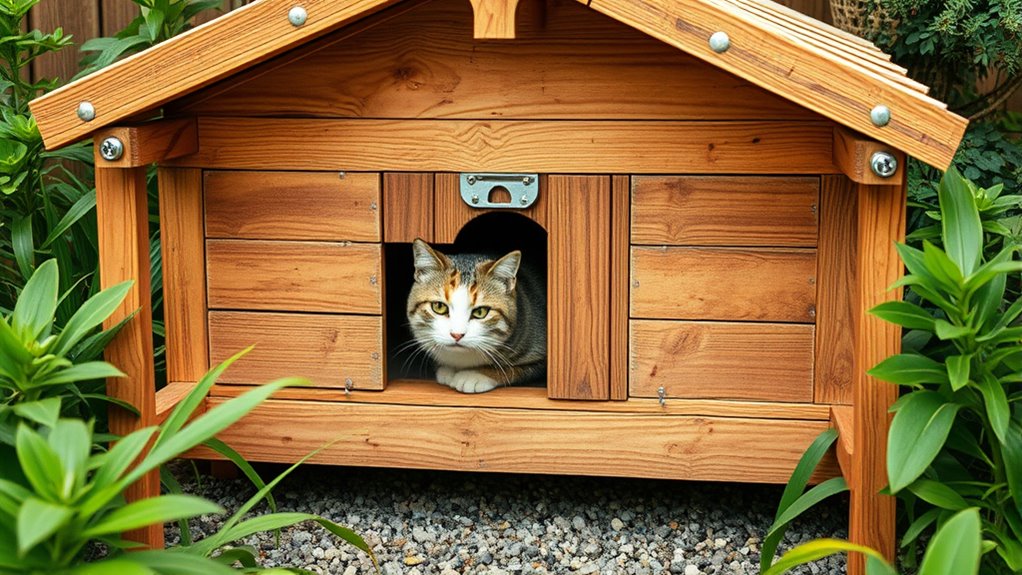
To make certain your outdoor cat shelter can withstand harsh weather and potential encounters with predators, you need to firmly secure its structure. Strong anchoring prevents the shelter from shifting or toppling during storms, ensuring safety and comfort for your cat. Also, consider shelter aesthetics—blending it with the environment can reduce curiosity from predators. Proper anchoring methods include stakes, weights, or secure foundations. Use the following ideas to reinforce your shelter:
| Method | Benefits |
|---|---|
| Anchoring stakes | Easy to install, stable |
| Heavy weights | No impact on shelter design |
| Secured foundation | Long-term durability |
Ensuring stability aligns with understanding cat behavior, keeping your feline safe while maintaining a discreet, appealing shelter.
Maintaining and Monitoring for Continued Safety
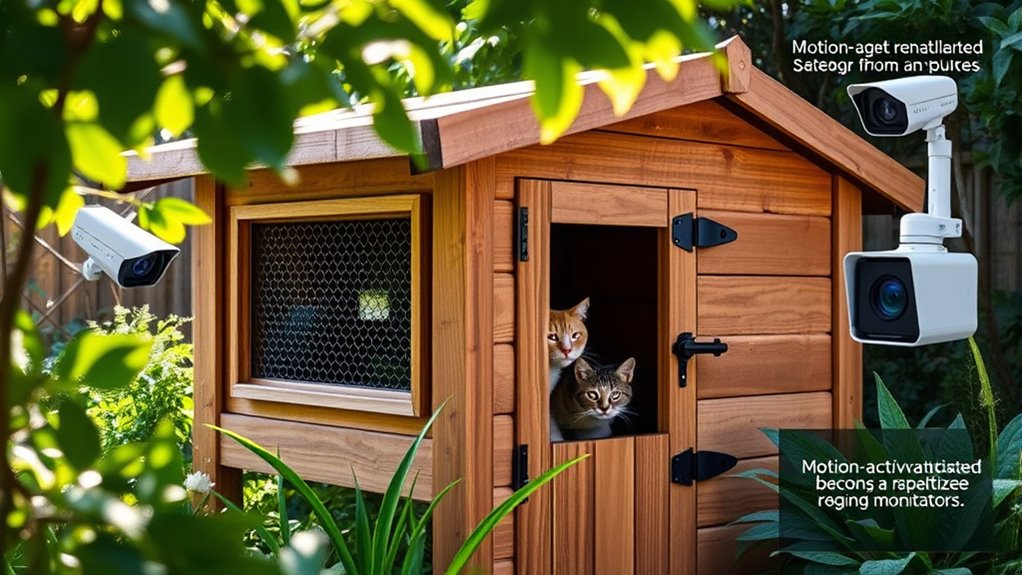
You need to regularly inspect your shelter to catch any damage or weak spots early. Keep an eye out for signs of predators trying to approach or breach the enclosure. Additionally, maintain a clean environment inside and around the shelter to prevent attracting unwanted visitors.
Regular Shelter Inspections
Regular shelter inspections are essential to make certain your outdoor cat shelter remains safe and secure over time. Conduct routine checks to identify damage or vulnerabilities early. Focus on these key areas:
- Examine the structure for holes or gaps that could allow predator entry.
- Ensure bird proofing measures are intact to prevent nests or debris that attract predators.
- Track predator activity signs, such as footprints or scratches, around the shelter.
- Verify that ventilation and access points remain secure and functional.
Monitor for Predators
Since predators can be persistent, actively monitoring your outdoor cat shelter is vital for ongoing safety. Regularly check for signs of predator activity, such as disturbed bedding or footprints. Bird proofing is essential—you want to prevent birds of prey from spotting your cat shelter easily. Use protective covers or netting to keep birds away and reduce the risk of attracting predators. Additionally, consider scent masking techniques, like using natural repellents, to make the shelter less detectable to predators that rely on smell. Stay vigilant during different times of day, especially dawn and dusk when predators are most active. By consistently monitoring and adjusting your predator-proofing efforts, you can guarantee your cat remains safe and secure in its outdoor environment.
Maintain Clean Environment
Keeping the shelter clean plays a vital role in maintaining a safe environment for your cat. Regular upkeep prevents pests and odors that attract predators. To guarantee safety, consider these steps:
- Remove debris and old bedding weekly to reduce hiding spots for pests.
- Check garden landscaping around the shelter for overgrown plants that could conceal predators.
- Clean and disinfect surfaces to prevent bacteria buildup.
- Maintain outdoor lighting to deter nocturnal predators and improve visibility.
Consistent cleaning discourages pests and ensures proper airflow. Proper garden landscaping minimizes hiding places near the shelter, while well-placed outdoor lighting enhances safety at night. By staying vigilant and maintaining a clean, well-lit environment, you better protect your cat from threats and ensure their shelter remains safe and predator-proof.
Frequently Asked Questions
How Often Should I Inspect the Shelter for Predator Damage?
You should inspect your shelter regularly for predator damage, ideally on a weekly basis. Establishing a consistent shelter maintenance schedule helps you stay ahead of wildlife interactions that could threaten your cats. During each inspection, look for signs of tampering, holes, or any damage that predators might exploit. Promptly fixing issues guarantees your shelter remains safe, secure, and predator-proof, providing peace of mind for both you and your cats.
Can I Use Recycled Materials for Building a Predator-Proof Shelter?
Yes, you can use recycled materials for building a predator-proof shelter. Recycling options like sturdy wood pallets, metal scraps, or old plastic containers work well. Just make sure these eco-friendly materials are durable, predator-resistant, and safe for your cat. Avoid sharp edges and toxic substances. Using recycled materials not only reduces waste but also creates an eco-friendly shelter that keeps your feline safe from predators.
What Is the Ideal Size for a Predator-Proof Outdoor Cat Shelter?
You should think of your cat’s shelter as a cozy retreat, ideally around 2-4 feet long, 1-2 feet wide, and 1-2 feet high, providing enough space for comfort without excess. Proper shelter insulation keeps warmth in, while predator-proof locks guarantee safety. A well-sized refuge offers peace of mind, allowing your feline friend to feel secure and protected, especially when equipped with quality locks and insulation to deter unwelcome visitors.
How Do I Prevent Other Animals From Invading the Shelter?
To prevent other animals from invading your shelter, you can install electric fences around the perimeter, which deliver a gentle shock to deter intruders. Additionally, use motion-activated deterrents like sprinklers or lights to scare off unwanted visitors. These methods work together to protect your cats, making it less likely for predators or other animals to enter. Regularly check and maintain these devices to guarantee continuous protection.
Are There Specific Plants That Help Camouflage the Shelter Naturally?
Think of your shelter as a hidden treasure chest, blending seamlessly into the landscape. Camouflage plants like tall grasses, dense bushes, and climbing vines offer natural concealment, making it harder for predators to spot your cat’s safe haven. By choosing these camouflage plants, you create an environment that feels like part of nature’s secret hideaway, offering your feline friend peace and safety while maintaining a discreet, natural look.
Conclusion
Creating a predator-proof outdoor cat shelter might seem challenging, but with the right materials and design, you can keep your feline safe and secure. Some worry it’s too much effort, but once you build it right, maintenance is minimal. Regular checks guarantee it stays secure and functional. Investing time now means your cat can enjoy the outdoors safely, giving you peace of mind without constant worry. Protect your cat today—it’s worth the effort!

